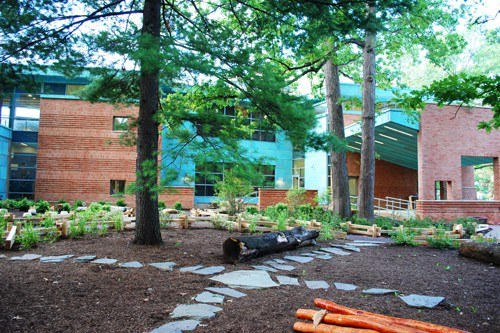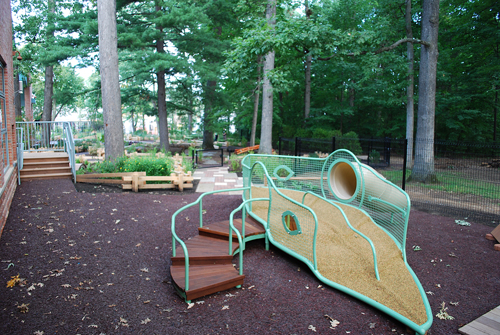Posted: February 5, 2015
Children and nature have always been connected.

"The original playscapes--before day care centers and playgrounds--were the fields, woods, paths, and streams near children's homes. Through experience with nature's wonders in the form of sand, water, mud, trees, rocks, bushes, worms, children received all the necessary motor stimulation." (Olds 2001)
When young children are exposed to nature, they see beauty just as adults do; but more importantly they begin to interact with its offerings. Children automatically become hands-on in nature. They begin to wonder. Natural materials such as pinecones, grass, rocks, leaves, rain, spider webs, sticks, frogs, fossils, dirt, seashells, pebbles, sand and water provide endless possibilities for play and imagination.
Today children play in a yard (if they have a yard), on the child care playground, on school and community playgrounds, in parks and areas designed for leisure use. Often these environments are man-made environments featuring commercially-made equipment from synthetic materials with little or no natural ground cover. In these outdoor environments children are not as connected to nature as in the past. One way to increase the connection is to create a nature scape.
So what is a nature scape? A nature scape is an inviting natural outdoor space where children connect to nature when they play. It is often a collaborative project, with landscape planners, environmentalists, designers, dreamers, crafts-people, child care providers, and parents coming together to plan and create a nature scape, turning concrete playgrounds back into natural playgrounds using natural materials.
Nature scapes bring nature back to the area. Trees are planted for shade and children walk on grass or soft mulch. Nature scapes may include hills for children to run up and down or slides embedded in the side of a hill. Other obstacles that may be included in a nature scape include an obstacle course, a sand area, rocks to turn over or walk on, a tunnel made from a tree trunk, and an area where water is available. This is just a beginning.
Analyze the physical environment
To create a nature scape, early care professionals must first analyze the physical environment that is used for outdoor play.
- Is the outdoors available on a daily basis?
- Are there functional areas for playing? (sand, water, rock, dramatic play, music, art, literacy)
- Are there spaces where children can be alone, and areas where small groups can work together?
- Are outdoor materials organized, labeled, and stored so they are easy to set up and clean up?
- Is the outdoor environment inspected before children go outside, so they do not have to wait? (done before the children arrive or by another staff team member)
- Can all children use props freely? (i.e., pots and pans from dramatic play to make soup with water, grass and dirt)
Design the layout
The next step is to design the layout of the nature scape. Components to include are:
- Define the perimeter. Enclose the nature scape with a perimeter fence that blends with the environment, or use a hedgerow or other natural barriers.
- Create spaces for gathering. Use benches, amphitheaters, stumps.
- Create places of shelter. Use sticks, blankets, twine, tarps, clothespins to create a special outdoor space.
- Include sand or dirt pits. How big and deep should the sand pit be? Make them 18-24 inches deep, and the size depends on the number of children. Each child needs at least 10 square feet. Wet the sand every evening to keep little critters out of the space. Think about possibilities with wet sand versus dry sand.
- Use vertical spaces. Create art walls, musical fences, planters, and water walls on fences.
- Get organized, and plan for outdoor equipment storage. A storage shed should be no deeper than 3-4 feet. Bikes could be stored on the bottom, with a shelf above to store programming materials and loose parts.

Materials, natural pieces, and activities
Finally, decide what materials, natural pieces, and activities to include in the nature scape. Below are core items to add to a nature scape, with a few suggestions for use.
Loose parts: Logs, stumps, tree blocks, lumber scraps, recycled Christmas trees.
- Stumps can be made into tables, seats, parts for a fort, bug homes, stages and platforms.
- Make a tipi from long sticks.
- Create an obstacle course using tree blocks, cookies, and logs.
- Christmas trees can be used to make a winter fort, as a giant bird feeder, and as bird shelters.
Boulders: Large heavy rocks children can climb, stand on, and sit on.
- Spacing should be 6-18 inches apart for stepping stones, or 6 feet apart for individual standing rocks. Spread the rocks around the area.
- Sources can be local famers and tree nurseries.
Sensory options
- Take old sensory tables outside.
- Create temporary sensory areas with plastic containers filled with loose parts found in nature: pine cones, acorns, grass, small pebbles, seeds, etc.
- Props for sensory areas can include pots, pans, cookie sheets, utensils, dishes, flowers.
Nature provokes children into thought, action, and formulating their own ideas. When children are involved in experiences with nature they are absorbed and completely attentive to what is at hand. Include more nature into your program; there are many advantages to all types of exposure to nature. Even if you can't create a nature scape, give the children in your program regular exposure to nature through going for a walk, playing in the yard, hiking in the woods, or visiting local parks and nature areas.
References
- Bienenstock, Adam and Jill. Bienenstock Playgrounds.
- Olds, Anita Rui. 2001. Child Care Design Guide. New York: McGraw Hill.
- Rivkin, Mary S., and Deborah Schein. 2014. The Great Outdoors: Advocating for Natural Spaces for Young Children, Revised Edition. National Association for the Education of Young Children.

